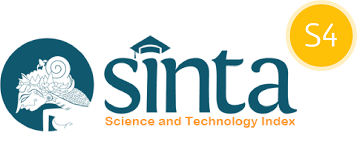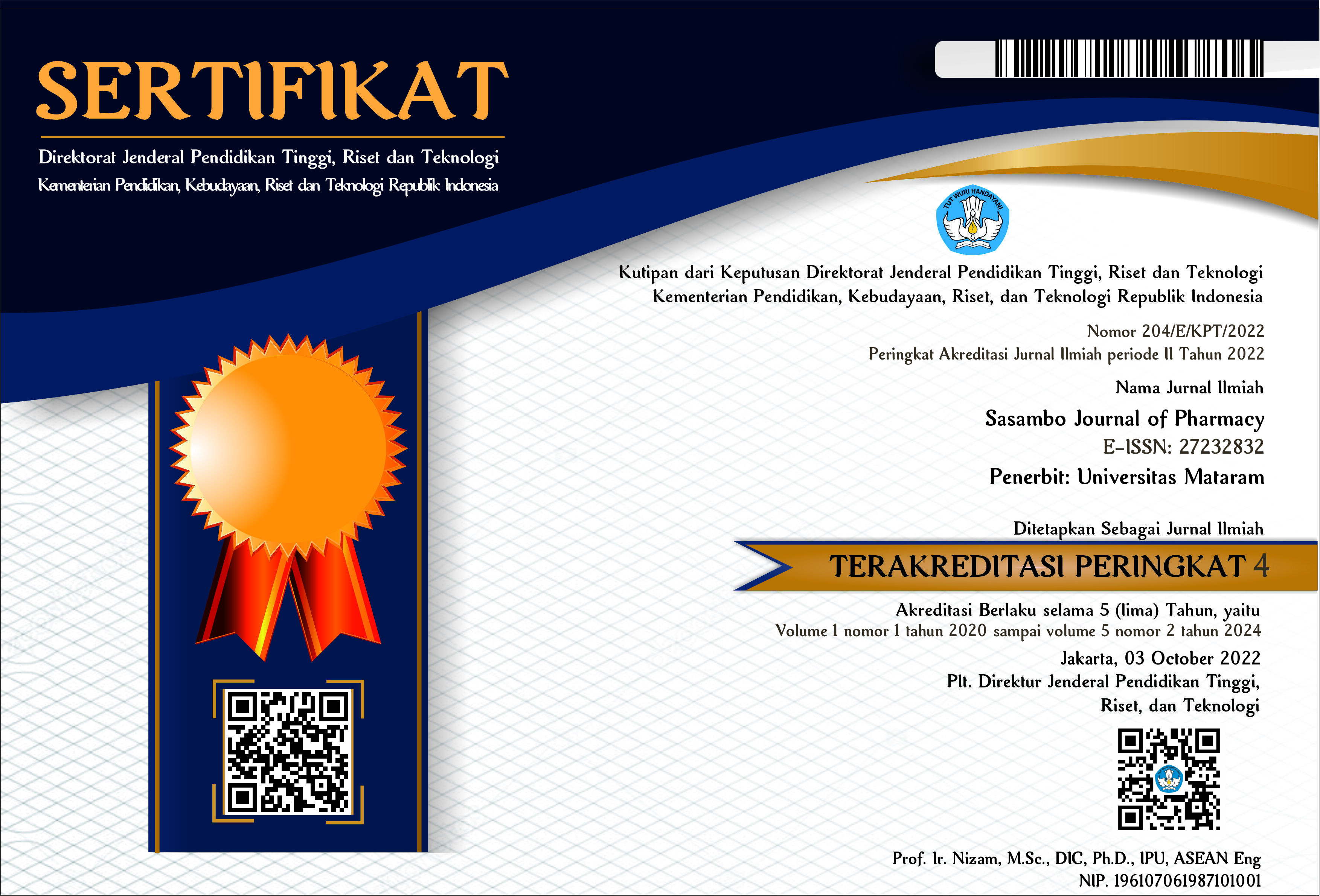Evaluation of formula and antibacterial activity of spray preparation from combination of aloe vera (Aloe vera L.) and lime concentrate (Citrus aurantiifolia) as hand sanitizer
DOI:
10.29303/sjp.v6i1.513Downloads
Abstract
Aloe vera plant (Aloe vera l.) has antioxidant activity and can be used as a moisturizer, especially on the inside of the leaves. Lime plant (Citrus aurantiifolia) has antibacterial activity, one of the compounds it contains is limonene. This study aims to evaluate the formula and antibacterial activity of a spray preparation combining aloe vera and lime concentrate as a Hand Sanitizer. The Hand Sanitizer spray formulation consists of four formulas with variations in the concentration of aloe vera and lime concentrate, namely F0 (0), F1 (30:20), F2 (25:25), and F3 (20:30). The evaluation carried out for 28 days includes organoleptic tests, homogeneity, pH, viscosity, drying time, and antibacterial activity. The organoleptic and homogeneity test results showed that F1, F2, and F3 were in homogeneous liquid form, cloudy orange in color, and had a distinctive lime aroma. The pH test obtained a range of 3.75-5.79. The viscosity test obtained a viscosity range of 1.06-1.29 cps. The drying time test obtained a time range of 33-46 seconds. The results of the antibacterial activity test showed that the highest inhibitory value was in formula F3 with values (14.5±0.2nm), followed by Formula F2 (11.5±0.45nm) and F1 (8.2±0.25nm). Based on statistical testing, it was concluded that there was an effect of each formula on antibacterial activity.
Keywords:
Aloe vera, Anti-bacterial, Hand-sanitizer, Lime, SprayReferences
Agustin, E. & Yanti, N. (2023). Formulation and Evaluation of Dayak Union Extract (Eleutherine palmifolia L. Merr) in Gel Preparations as Antiacne. Jurnal Sains Dan Kesehatan, 5(5), 751-758.
Asngad, A., R, A. B., & Nopitasari, N. (2018). Kualitas Gel Pembersih Tangan (Handsanitizer) dari Ekstrak Batang Pisang dengan Penambahan Alkohol, Triklosan dan Gliserin yang Berbeda Dosisnya. Bioeksperimen: Jurnal Penelitian Biologi, 4(2), 61–70.
Ayun, N. Q., Erawati, T., Prakoeswo, C. R. S., & Soeratri, W. (2020). Karakteristik dan Stabilitas Fisik Krim Amniotic Membrane Stem Cell Metabolite Product dengan Penambahan SPACE Peptide. Jurnal Farmasi Dan Ilmu Kefarmasian Indonesia, 7(1), 19.
Diana, A. R., Hendrarini, L., & Narto, N. (2013). Diseminasi Oleh Dokter Kecil tentang Penggunaan Hand Sanitizer Berbentuk Gel dan Spray untuk Menurunkan Angka Kuman Tangan Siswa SDN Demakijo I Di Gamping Sleman, Yogyakarta. Jurnal Kesehatan Lingkungan, 4(3), 129–135.
Gusman, T. A., Sari, G. N., Nurudin, A., Yulina, I. K., & Munnawarah, A. (2022). Upaya Pencegahan Covid-19 dengan Pembuatan Hand Sanitizer Alami Ekstrak Daun Sirih. Jurnal Widya Laksana, 11(2), 236–244.
Hita, I. P. G. A. P., Ardinata, I. P. R., & Wardhana, Z. F. (2023). Optimalisasi Aktivitas Antibakteri Ekstrak Etanol 70% Daun Binahong Terhadap Bakteri Staphylococcus aureus. Medfarm: Jurnal Farmasi Dan Kesehatan, 12(1), 58–66.
Indalifiany, A., Malaka, M. H., Sahidin, Fristiohady, A., & Andriani, R. (2021). Formulation and Physical Stability Test of Nanoemulgel Containing Petrosia Sp. Jurnal Farmasi Sains Dan Praktis (JFSP), 7(3), 321–331.
Lestari, R. K., Amalia, E., & Yuwono, Y. (2022). Efektivitas Jeruk Nipis (Citrus aurantifolia Swingle) Sebagai Zat Antiseptik Pada Cuci Tangan. Jurnal Kedokteran Dan Kesehatan: Publikasi Ilmiah Fakultas Kedokteran Universitas Sriwijaya, 5(2), 55–65.
Marhaeni, L. S. (2020). Potensi Lidah Buaya (Aloe vera Linn) Sebagai Obat dan Sumber Pangan. Jurnal Ilmu-Ilmu Pertanian, 13(1), 32–39.
Martono, C., & Suharyani, I. (2018). Formulasi Sediaan Spray Gel Antiseptik dari Ekstrak Etanol Lidah Buaya (Aloe vera). Jurnal Farmasi Muhammadiya Kuningan, 3(1), 29–37.
Mengga, D. W., Tulandi, S. S., Astuti, W., Tumbel, S. L., & Potalangi, N. O. (2021). Uji Efektivitas Antibakteri Sari Buah Jeruk Nipis (Citrus aurantifolia Swingle) Terhadap Bakteri Staphylococcus aureus. Jurnal Info Sains, 2(2), 20–26.
Puspita, W., Hairunnisa, H., & Awaliah, P. D. (2020). Efektivitas Antibakteri Sediaan Sirup Air Perasan Buah Jeruk Nipis (Citrus aurentifolia) Terhadap Bakteri Staphylococcus aereus Secara In Vitro. Jurnal Ilmiah Farmako Bahari, 11(1), 38–45.
M. Rahardjo,E. B. Koendhori & Y. Setiawati. (2017). Uji Aktivitas Antibakteri Ekstrak Etanol Lidah Buaya (Aloe vera) Terhadap Bakteri Staphylococcus aureus. Jurnal Kedokteran Syiah Kuala, 17(2), 65-70.
Rollando, R., Ongkowijoyo, G. N., Yoedistira, C. D., & Monica, E. (2023). Pengembangan Analisis Metil Paraben dan Propil Paraben Pada Sediaan Kosmetik dengan Menggunakan Spektrofotometer Derivatif dan Kemometrik Multivariat. Jurnal Ilmu Farmasi Dan Farmasi Klinik, 20(1), 10.
Saputri, D., Pratama, A. A., Iza, L., & Rohmawati, L. (2021). Pembuatan Handsanitizer Bahan Alam dari Ekstrak Lidah Buaya dan Daun Sirih. Jurnal Nasional Fisika, 2(2), 174–177.
Sari AN & Asri MT. (2022). Aktivitas Antibakteri Ekstrak Kulit Jeruk Nipis (Citrus aurantifolia) terhadap Pertumbuhan Bakteri Shigella dysenteriae. Lenterabio. 11(3): 441-448.
License
Copyright (c) 2025 The Author(s)

This work is licensed under a Creative Commons Attribution 4.0 International License.
Authors who publish with Sasambo Journal of Pharmacy (SJP), agree to the following terms:
- Authors retain copyright and grant the journal right of first publication with the work simultaneously licensed under a Lisensi Creative Commons Atribusi 4.0 Internasional. This license allows authors to use all articles, data sets, graphics and appendices in data mining applications, search engines, web sites, blogs, and other platforms by providing an appropriate reference. The journal allows the author(s) to hold the copyright without restrictions and will retain publishing rights without restrictions.
- Authors are able to enter into separate, additional contractual arrangements for the non-exclusive distribution of the journal's published version of the work (e.g., post it to an institutional repository or publish it in a book), with an acknowledgment of its initial publication in Sasambo Journal of Pharmacy
- Authors are permitted and encouraged to post their work online (e.g., in institutional repositories or on their website) prior to and during the submission process, as it can lead to productive exchanges, as well as earlier and greater citation of published work (See The Effect of Open Access).







